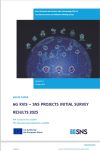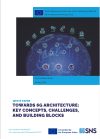Contributions to White Papers

6G KPIs – Definitions and Target Values
SNS JU Test Measurement and Validation WG
Jan. 2025
The Test, Measurement, and KPIs Validation (TMV) Working Group (WG) of SNS JU focuses on developing and sharing best practices for 6G testing, monitoring, and analytics. The TMV WG aims to promote common methodologies across projects, support 6G trial Use Cases (UCs), and ensure a unified European vision for the 6G network lifecycle. A key objective is the definition and validation of performance KPIs. This white paper consolidates 6G KPIs from SNS JU projects, providing definitions, target values, and context to shape the 6G vision. Furthermore, the TMV WG promotes common collection procedures, validation methodologies, and analysis of KPI metrics. Various SNS JU projects provided the KPIs, which drive their technical developments.

6G KVIs – SNS Projects Initial Survey Results 2025
SNS JU Test Measurement and Validation WG
May 2025
The Test, Measurement, and Validation (TMV) Working Group (WG) of SNS JU focuses on developing and sharing related experiences and best practices for 6G networks testing, monitoring, and assessment from various perspectives. More specifically, besides its strong focus on 6G networks’ technical performance, the TMV-WG, through the KVIs sub-working group, aims to set the scene for 6G networks’ impact monitoring and validation from the emerging dimension of Key Value Indicators (KVIs).
Within this context, the TMV WG aims to record, report, and promote state-of-the-art and new innovative methodologies for the monitoring and evaluation of the foreseen impact of the 6G networks on Key Values, as identified by SNS-JU projects.
This work leverages the methodology and previous work of 6G-IA on the definition of values and KVIs – which still progresses in the context of 6G-IA SNVC (Societal Needs and Value Creation Sub-Group) – addressing the dimension of evaluation of KVIs. To this end, various SNS JU projects provided the KVIs and information on how these can or will be evaluated in accordance with the use cases that are addressed. To align with the SNVC methodology, the main reported KVIs were classified into categories based on the impacted Key Values (KVs).
The identified categories of KVs are:
KV #1 – Environmental Sustainability,
KV #2 – Societal Sustainability,
KV #3 – Economic Sustainability & Innovation,
KV #4 – Democracy,
KV #5 – Cultural Connection,
KV #6 – Knowledge,
KV #7 – Privacy & Confidentiality,
KV #8 – Simplified Life,
KV#9 – Digital Inclusion,
KV#10 – Personal Freedom,
KV#11 – Personal Health & Protection from Harm, and
KV #12 – Trust.
This categorisation utilised within the present whitepaper does not represent or stand for a final proposal of classification of the Key Values, rather, it is utilised as a point of reference for many of the research projects that participated in the questionnaires.

Towards 6G Architecture: Key Concepts, Challenges, and Building Blocks
SNS JU 6G Architecture WG
May 2025
We are entering the standardization phase for the 6th generation (6G) of wireless technologies. While valuable lessons have been learned from the design, deployment, and operation of 5G and Beyond in Europe, new requirements, emerging technologies, and evolving business models must be natively integrated into the next-generation mobile network architecture.
This white paper presents a comprehensive snapshot of the current architectural considerations explored by the Smart Networks and Services Joint Undertaking (SNS-JU) projects. It aims to discuss the rationale for novel architectural components, the ongoing design efforts, and the future outlook for 6G.
We analyse the blueprint for next-generation mobile networks, building on past experiences while integrating cutting-edge advancements. The structure follows the IMT-2030 framework, categorizing insights into the key usage scenarios and overarching architectural aspects.
– Usage Scenarios: We analyse the evolution of IMT-2030 paradigms, focusing on Immersive, Massive, and Hyper-Reliable Low-Latency Communications. We also explore novel 6G enablers, such as Ubiquitous Connectivity, AI-driven Communication, and Integrated Sensing & Communication.
– Overarching Aspects: The next-generation architecture must natively embed Security, Privacy & Trustworthiness, Sustainability, and Network Exposure Capabilities—ensuring these critical aspects are foundationally considered rather than retroactively incorporated.
Finally, we conclude by outlining the essential building blocks shaping the next-generation mobile network architecture, highlighting the most promising research paths identified in this white paper.
